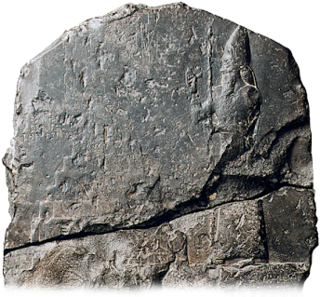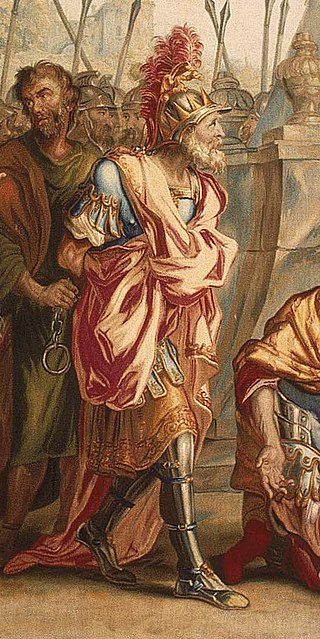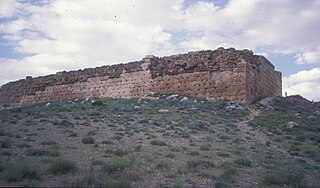
Nebuchadnezzar II, also spelled Nebuchadrezzar II, was the second king of the Neo-Babylonian Empire, ruling from the death of his father Nabopolassar in 605 BC to his own death in 562 BC. Historically known as Nebuchadnezzar the Great, he is typically regarded as the empire's greatest king. Nebuchadnezzar remains famous for his military campaigns in the Levant, for his construction projects in his capital, Babylon, including the Hanging Gardens of Babylon, and for the role he plays in Jewish history. Ruling for 43 years, Nebuchadnezzar was the longest-reigning king of the Babylonian dynasty. By the time of his death, he was among the most powerful rulers in the world.
Neriglissar was the fourth king of the Neo-Babylonian Empire, ruling from his usurpation of the throne in 560 BC to his death in 556 BC. Though unrelated to previous Babylonian kings, possibly being of Aramean ancestry, Neriglissar was a prominent official and general in the reign of Nebuchadnezzar II and became even more influential through marrying one of Nebuchadnezzar's daughters, possibly Kashshaya.

Belshazzar was the son and crown prince of Nabonidus, the last king of the Neo-Babylonian Empire. Through his mother, he might have been a grandson of Nebuchadnezzar II, though this is not certain and the claims to kinship with Nebuchadnezzar may have originated from royal propaganda.

Nabonidus was the last king of the Neo-Babylonian Empire, ruling from 556 BC to the fall of Babylon to the Achaemenian Empire under Cyrus the Great in 539 BC. Nabonidus was the last native ruler of ancient Mesopotamia, the end of his reign marking the end of thousands of years of Sumero-Akkadian states, kingdoms and empires. He was also the last independent king of Babylon. Regarded as one of the most vibrant and individualistic rulers of his time, Nabonidus is characterised by some scholars as an unorthodox religious reformer and as the first archaeologist.

Amel-Marduk, also known as Awil-Marduk, or under the biblical rendition of his name, Evil-Merodach, was the third emperor of the Neo-Babylonian Empire, ruling from 562 BCE until his overthrow and murder in 560 BCE. He was the successor of Nebuchadnezzar II. On account of the small number of surviving cuneiform sources, little is known of Amel-Marduk's reign and actions as king.
Labashi-Marduk was the fifth and penultimate king of the Neo-Babylonian Empire, ruling in 556 BC. He was the son and successor of Neriglissar. Though classical authors such as Berossus wrote that Labashi-Marduk was just a child when he became king, Babylonian documents indicate that he had been in charge of his own affairs before his rise to the throne, suggesting he was an adult, though possibly still relatively young.

Belshazzar's feast, or the story of the writing on the wall, chapter 5 in the Book of Daniel, tells how Belshazzar holds a great feast and drinks from the vessels that had been looted in the destruction of the First Temple. A hand appears and writes on the wall. The terrified Belshazzar calls for his wise men, but they are unable to read the writing. The queen advises him to send for Daniel, renowned for his wisdom. Daniel reminds Belshazzar that his father Nebuchadnezzar, when he became arrogant, was thrown down until he learned that God has sovereignty over the kingdom of men. Belshazzar had likewise blasphemed God, and so God sent this hand. Daniel then reads the message and interprets it: God has numbered Belshazzar's days, he has been weighed and found wanting, and his kingdom will be given to the Medes and the Persians.
That very night Belshazzar, the Chaldean [Babylonian] king, was killed. And Darius the Mede received the kingdom […]
Nitocris possibly was the last queen of the Sixth Dynasty of Ancient Egypt. Her name is found in writings long considered as relatively accurate resources: a major chronological documentation of the reigns of the kings of ancient Egypt that was composed in the third-century BC by Manetho, an Ancient Egyptian priest and by the ancient Greek historian, Herodotus, in his Histories. She is thought to be the daughter of Pepi II and Neith and to be the sister of Merenre Nemtyemsaf II.

Astyages was the last king of the Median kingdom, reigning from 585 to 550 BCE. The son of Cyaxares, he was dethroned by the Persian king Cyrus the Great.

Darius the Mede is mentioned in the Book of Daniel as King of Babylon between Belshazzar and Cyrus the Great, but he is not known to secular history and there is no space in the historical timeline between those two verified rulers. Belshazzar, who is often mentioned as king in the book of Daniël, was in fact the crown-prince and governor while his father was in Arabia from ca. 553 to 543 BCE, but Nabonidus had returned to Babylon years before the fall of the Babylonian empire.

The Neo-Babylonian Empire or Second Babylonian Empire, historically known as the Chaldean Empire, was the last polity ruled by monarchs native to Mesopotamia until Faisal II in the 20th century. Beginning with the coronation of Nabopolassar as the King of Babylon in 626 BC and being firmly established through the fall of the Assyrian Empire in 612 BC, the Neo-Babylonian Empire was conquered by the Achaemenid Persian Empire in 539 BC, marking the collapse of the Chaldean dynasty less than a century after its founding.

The Chaldean dynasty, also known as the Neo-Babylonian dynasty and enumerated as Dynasty X of Babylon, was the ruling dynasty of the Neo-Babylonian Empire, ruling as kings of Babylon from the ascent of Nabopolassar in 626 BC to the fall of Babylon in 539 BC. The dynasty, as connected to Nabopolassar through descent, was deposed in 560 BC by the Aramean official Neriglissar, though he was connected to the Chaldean kings through marriage and his son and successor, Labashi-Marduk, might have reintroduced the bloodline to the throne. The final Neo-Babylonian king, Nabonidus, was genealogically unconnected to the previous kings, but might, like Neriglissar, also have been connected to the dynasty through marriage.

Nebuchadnezzar IV, alternatively spelled Nebuchadrezzar IV and also known by his original name Arakha, was a nobleman of Urartu's Satrapy of Armenia of Urartian (Armenian) descent who in 521 BCE seized power in Babylon, becoming the city's king and leading a revolt against the Persian Achaemenid Empire. His revolt began less than a year after the unsuccessful revolt of Nebuchadnezzar III. Like his predecessor, Arakha assumed the name Nebuchadnezzar and claimed to be a son of Nabonidus, Babylon's last independent king.
Cyaxares II was a king of the Medes whose reign is described by the Greek historian Xenophon. Some theories have equated this figure with the "Darius the Mede" named in the Book of Daniel. He is not mentioned in the histories of Herodotus or Ctesias, and many scholars doubt that he actually existed. The question of his existence impacts on whether the kingdom of the Medes merged peacefully with that of the Persians in about 537 BC, as narrated by Xenophon, or was subjugated in the rebellion of the Persians against Cyrus' grandfather in 559 BC, a date derived from Herodotus (1.214) and almost universally accepted by current scholarship.
The Battle of Opis was the last major military engagement between the Achaemenid Empire and the Neo-Babylonian Empire, which took place in September 539 BC, during the Persian invasion of Mesopotamia. At the time, Babylonia was the last major power in Western Asia that was not yet under Persian control. The battle was fought in or near the strategic riverside city of Opis, located north of the capital city of Babylon in modern-day Iraq, and resulted in a decisive victory for Persia. Shortly afterwards, the Babylonian city of Sippar surrendered to Persian forces, who then supposedly entered Babylon without facing any further resistance. The Persian king Cyrus the Great was subsequently proclaimed as the king of Babylonia and its subject territories, thus ending its independence and incorporating the entirety of the fallen Neo-Babylonian Empire into the greater Achaemenid Empire.

The Medo-Persian conflict was a military campaign led by the Median king Astyages against Persis in the mid 6th-century BCE. Classical sources claim that Persis had been a vassal of the Median kingdom that revolted against Median rule, but this is not confirmed by contemporary evidence. After some battles the Persians led by Cyrus the Great emerged victorious, subsequently conquering Median territories and establishing the Achaemenid Empire.

The fall of Babylon was the decisive event that marked the total defeat of the Neo-Babylonian Empire to the Achaemenid Empire in 539 BC.
Adad-guppi, also known as Addagoppe, was a devotee of the moon god Sîn in the northern Assyrian city of Harran, and the mother of King Nabonidus of the Neo-Babylonian Empire.
Ennigaldi-Nanna, also known as Bel-Shalti-Nanna and commonly called just Ennigaldi, was a princess of the Neo-Babylonian Empire and high priestess (entu) of Ur. As the first entu in six centuries, serving as the "human wife" of the moon-god Sin, Ennigaldi held large religious and political power. She is most famous today for founding a museum in Ur c. 530 BC. Ennigaldi's museum showcased, cataloged, and labelled artifacts from the preceding 1,500 years of Mesopotamian history and is often considered to have been the first museum in world history.
Nabu-balatsu-iqbi was the father of the Neo-Babylonian king Nabonidus. A mysterious figure, Nabu-balatsu-iqbi is only referenced in Nabonidus's own inscriptions, with no other record of his existence or status.












